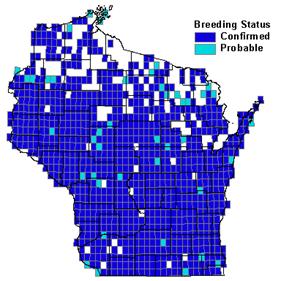

Status/Protection
- Global Rank: G5 Key to global and state ranks
- State Rank: S5B,SZN
- WBCI Priority: PIF
Population Information
The Federal BBS information can be obtained at http://www.mbr-pwrc.usgs.gov/bbs/bbs.html by clicking on Trend Estimates and selecting the species in question. All estimates are for time period (1966-2005).
- Federal Breeding Bird Survey: significant decline
- Federal Breeding Bird Survey (WI): no change
- Federal Breeding Bird Survey (BCR 23): non-significant decline
- Federal Breeding Bird Survey (BCR 12): significant decline
- Nicolet National Forest Bird Survey (UWGB): significant decline (Howe and Roberts 2005)
- WSO Checklist Project: significant decline (1983-2007)
Life History
- Breeding Range: Throughout most of U.S. and Canada and into central Mexico.
- Breeding Habitat: Wide variety of open grassland, wetland, and rural habitats with access to a man-made or natural overhang for nesting.
- Nest: Saucer-type nest under ledge, cave, culvert, bridge, outbuilding, barn, and many other human-made structures that offer security from the elements (Ehrlich et al. 1988).
- Nesting Dates: Eggs: mid-May to early August (Robbins 1991, Davis and Davis 2006).
- Foraging: Aerial forage, rarely berries and seeds (Ehrlich et al.1988).
- Migrant Status: Neotropical migrant.
- Habitat use during Migration: Variety of habitats including open fields, wetlands, towns (Brown and Brown 1999).
- Arrival Dates: Mid-April to mid-May (Robbins 1991).
- Departure Dates: Early August to early October (Robbins 1991).
- Winter Range: Majority of population winters in South American lowlands, but also occur north through Central America (Brown and Brown 1999).
- Winter Habitat: Little information (Brown and Brown 1999).
Habitat Selection
Throughout its range, the Barn Swallow is a habitat generalist and uses a wide variety of open wetland, grassland and agricultural or rural habitats for foraging and nesting (Brown and Brown 1999, Davis and Davis 2006). In Wisconsin, it commonly nests in urban areas as well as open wetland and agricultural habitats. Nests are often placed under a horizontal ledge or overhang, such as those found on docks, barns, houses, bridges or cliffs and are located near an accessible mud source (Davis and Davis 2006).
Habitat Availability
The Barn Swallow population has undoubtedly increased across North America due to its ability to use man-made structures for nesting (Speich et al. 1986). These nest sites are abundant and widespread in Wisconsin and the Barn Swallow is consequently uniformly distributed throughout the state. Breeding activity was documented in nearly 85% of the quads surveyed during the Wisconsin Breeding Bird Atlas (Davis and Davis 2006).
Population Concerns
The Barn Swallow is widely distributed across most of North America and throughout Wisconsin, where it is considered a common summer resident (Robbins 1991). This species likely has benefited from human activities and may be much more abundant today than in pre-settlement times (Brown and Brown 1999). Nevertheless, recent population declines are cause for concern. Although the Breeding Bird Survey suggests a stable population trend for Wisconsin, other sources suggest a significant decline in the state (Howe and Roberts 2005, Rolley 2005) as well as elsewhere in its range (Sauer et al. 2005). As land use practices in rural areas intensify, foraging habitats and food resources may become more limited. Additionally, the aerial spraying of insecticides and pesticides reduces prey resources and has been implicated in the Barn Swallow’s decline in Israel (Brown and Brown 1999).
Recommended Management
Conservation efforts should protect and restore artificial nesting sites on buildings, bridges, and other overhanging structures adjacent to open agricultural and wetland habitats. Homeowners should consider using building materials compatible with this species’ nesting requirements (i.e., brick, stone, concrete) and limit use of vinyl or metal. In some cases, artificial platforms may be required. Limit the use of pesticides and other harmful chemicals in important nesting and foraging areas (Brown and Brown 1999).
Research Needs
More research is needed to identify population limiting factors, including the impact of pesticides on food resources. Information on winter habitat requirements for the North American Barn Swallow population is lacking and warrants study.
Information Sources
- Cornell Lab of Ornithology species account: http://www.birds.cornell.edu/AllAboutBirds/BirdGuide/Barn_Swallow.html
- Nicolet National Forest Bird survey map: http://www.uwgb.edu/birds/nnf/species/BARS.htm
- North American Breeding Bird Survey: http://www.mbr-pwrc.usgs.gov/bbs/bbs.html
- The Wisconsin Breeding Bird Atlas: http://www.uwgb.edu/wbba/
References
- Brown, C.R. and M.B. Brown.1999. Barn Swallow (Hirundo rustica). In The Birds of North America, No. 452 (A. Poole and F. Gill, eds.). The Birds of North America, Inc., Philadelphia, PA.
- Davis G. and J. Davis 2006. Barn Swallow. In Atlas of the Breeding Birds of Wisconsin. (N.J. Cutright, B.R. Harriman, and R.W. Howe, eds.). The Wisconsin Society for Ornithology, Inc. 602pp.
- Howe, R.W. and L.J. Roberts. 2005. Sixteen years of habitat-based bird monitoring in the Nicolet National Forest. In C.J. Ralph and T.D. Rich, editors. Bird Conservation Implementation and Integration in the Americas: Proceedings of the Third International Partners in Flight Conference. 2002 March 20-24; Asilomar, California, Volume 2. Gen. Tech. Rep. PSW-GTR-191. Albany, CA: Pacific Southwest Research Station, Forest Service, U.S. Department of Agriculture. 643 p.
- Robbins, S.D. 1991. Wisconsin birdlife: population & distribution, past & present. Univ. of Wisconsin Press, Madison, WI.
- Rolley, R. 2005. Wisconsin Checklist Project. http://dnr.wi.gov/org/land/wildlife/harvest/reports/07checklist.pdf (27 june 2007)
- Sauer, J.R., J.E. Hines, and J. Fallon. 2005. The North American Breeding Bird Survey, Results and Analysis 1966 - 2005. Version 6.2.2006. USGS Patuxent Wildlife Research Center, Laurel, MD.
- Speich, S.M., H.L. Jones, and E.M. Benedict. 1986. Review of the natural nesting of the Barn Swallow in North America. Am. Midl. Nat. 115: 248–254.
Contact Information
- Compiler: Ken Damro, kendamro@yahoo.com | Andy Paulios, Andy.Paulios@Wisconsin.gov
- Editor: Kim Kreitinger, K.Kreitinger@gmail.com
